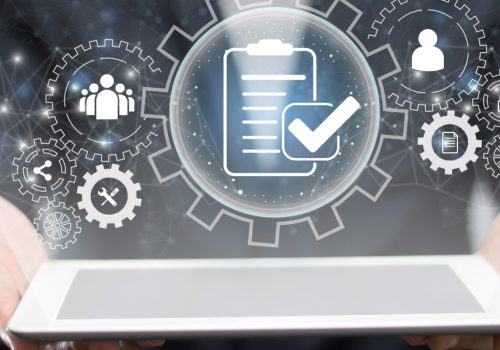In the fast-paced realm of technology, businesses find themselves at the crossroads of a digital revolution. As the landscape continues to be reshaped by emerging technologies, the impact on organizational processes is profound.
This article delves into the transformative journey that businesses are undertaking, navigating the promises of enhanced efficiency and the potential pitfalls that accompany this technological evolution.
The Current Business Landscape
In the ever-evolving world of business, the landscape is witnessing unprecedented shifts driven by technological advancements. According to a report by McKinsey & Company, the adoption of artificial intelligence (AI) technologies in businesses has the potential to create an additional $13 trillion in global economic activity by 2030. Notably, the same report found that the use of AI in business operations could lead to a 22% increase in profitability for companies, showcasing the transformative potential of emerging technologies.
In tandem with these findings, a survey by Deloitte underscores the urgency for businesses to embrace digital transformation. A staggering 94% of executives believe that digital transformation is a top priority for their organization, with 51% indicating that their company has already implemented some form of digital transformation.
These statistics underscore a collective acknowledgment within the business realm that the traditional approaches to organizational processes are no longer sufficient. Agility and adaptability, driven by technology, are becoming imperative for sustaining and thriving in this dynamic business environment.
The Technological Revolution
As businesses respond to the imperative of digital transformation, a technological revolution unfolds. Cutting-edge technologies, such as artificial intelligence, blockchain, the Internet of Things (IoT), and machine learning, are at the forefront of reshaping traditional business operations. These innovations hold the promise of not just optimizing existing processes but completely revolutionizing how businesses operate.
To gain insights into the maturity and potential impact of these technologies, we turn to the Gartner Hype Cycle for 2023. The report identifies and describes emerging technologies that are expected to have a significant impact on business and society over the next two to ten years.
The report identifies twenty-five emerging technologies that fall into the following four (4) themes:
- Emergent AI: This theme includes technologies such as generative AI, AI simulation, causal AI, federated machine learning, and graph data science. These technologies offer immense potential to enhance digital customer experiences, make better business decisions, and distinguish yourself from your competition.
- Developer Experience: This theme includes technologies such as low-code platforms, AI-assisted development, and cloud-native development. These technologies aim to improve developer productivity and efficiency and enable faster time-to-market.
- Pervasive Cloud: This theme includes technologies such as hybrid cloud computing, cloud security posture management, and cloud service mesh. These technologies aim to provide a more secure and efficient cloud environment and enable organizations to leverage the benefits of cloud computing.
- Human-Centric Security and Privacy: This theme includes technologies such as secure access service edge (SASE), confidential computing, and privacyenhancing computation. These technologies aim to provide a more secure and private digital environment and enable organizations to protect sensitive data and information.

This graphical representation offers a roadmap, divided into five stages, providing a nuanced understanding of the evolution of emerging technologies.
- Innovation Trigger: This is the stage where a technology is born. It is characterized by a lot of hype, media attention, and early proof-of-concept stories.
- Peak of Inflated Expectations: This is the stage where the technology is at the peak of its hype. It is characterized by unrealistic expectations, overexaggerated claims, and a lot of investment.
- Trough of Disillusionment: This is the stage where the technology fails to meet expectations and falls out of favor. It is characterized by negative press, failed projects, and a lot of disappointment.
- Slope of Enlightenment: This is the stage where the technology starts to mature and gain traction. It is characterized by successful case studies, growing adoption, and a lot of learning.
- Plateau of Productivity: This is the stage where the technology becomes mainstream and is widely adopted. It is characterized by stable growth, proven use cases, and a lot of success stories.
These insights highlight the dynamic nature of technological evolution and the importance of businesses navigating through these phases to make informed decisions about adoption. As organizations embrace these emerging technologies, promises of improved efficiency, enhanced customer experiences, and groundbreaking innovations beckon. The benefits span across industries, offering the potential for increased profitability, streamlined operations, and the creation of entirely new business models.
McKinsey & Company’s analysis of some of the more meaningful tech trends lays out a convincing case that something significant is happening. These tech trends are accelerating the primary characteristics that have defined the digital era: granularity, speed, and scale. But it is the magnitude of these changes—in computing power, bandwidth, and analytical sophistication—that is opening the door to new innovations, businesses, and business models.
Navigating Risk
While the promise of emerging technologies is immense, it comes with a set of challenges and risks that organizations must navigate effectively. As businesses embrace the digital revolution, several key areas of concern demand attention:
- Cybersecurity and Privacy: As we incorporate AI and IoT into our daily activities, new cybersecurity threats emerge, making our digital world more vulnerable. The significant increase in ransomware attacks shows the need for strong defenses. It is not about ransomware anymore; there are also new threats like Deep Fakes, which use AI to create realistic fake content. Privacy is a growing concern too. Beyond the usual worries, there is now the risk of identity spoofing, where someone pretends to be someone else online.
- Interoperability Challenges: A pivotal challenge confronting organizations is to ensure seamless connectivity and compatibility across diverse digital realms. For instance, the metaverse, while holding the promise of immersive digital experiences, faces complex interoperability challenges. True metaverse adoption, according to Gartner, is still a decade away. Organizations keen on exploring this space must grapple with issues of seamless connectivity and compatibility to realize the envisioned interconnected digital landscape.
- Regulatory Barriers: Innovations in Web3, Non- Fungible Tokens (NFTs), and decentralization signal a re-architecture of the internet. However, regulatory barriers loom ahead, presenting potential roadblocks to widespread adoption. Businesses must stay vigilant and proactive in navigating the evolving regulatory landscape to leverage the benefits of decentralized technologies.
- Consolidation Pressures: While advancements like quantum computing hold immense potential for various sectors, they remain in a phase of research and development. The consolidation of resources and efforts in this space is crucial to overcome the challenges and bring quantum computing to its plateau of productivity.
- Ethical Considerations in Technology: As AI technologies become more prevalent, ethical considerations come to the forefront. Ensuring responsible AI use, avoiding bias in algorithms, and maintaining transparency in decision-making processes are critical dimensions. The broader ethical considerations within the realm of technology challenge us to reflect on the societal impacts of our digital creations.
- Effectively navigating these risks requires a strategic approach, proactive cybersecurity measures, and a keen understanding of the regulatory landscape. Organizations that invest in risk mitigation strategies alongside technology adoption position themselves for long-term success in the digital era.
The Human Element
It is paramount to recognize the pivotal role of the human element in steering successful organizational transformations. As organizations embrace emerging technologies for efficiency and innovation, a conscientious focus on the workforce becomes not just a strategy but a necessity.
The heartbeat of this transformative journey lies in upskilling the workforce. A compelling study published in Information Systems Frontiers projects that by 2025, a staggering 50% of all employees will require reskilling to align with the adoption of modern technologies. This underscores the rapid pace at which the job market is evolving. In the next five years, over two-thirds of skills currently deemed crucial in today’s job landscape will undergo transformation. Moreover, a third of the essential skills in 2025 will revolve around technology competencies that are not yet regarded as pivotal in today’s job requirements.
As innovative technologies reshape the professional terrain, the demand for a workforce adept in the relevant skills becomes non-negotiable. Organizations are compelled to invest in comprehensive upskilling programs, empowering employees with the knowledge and capabilities necessary to navigate and harness the full potential of these technologies effectively.
Yet, technological transformations inherently introduce change, a prospect often met with resistance. Human nature tends to resist unfamiliar shifts in routine. Recognizing and addressing this resistance is integral to successful implementation. Clear communication, transparent planning, and employee involvement in the transition process can mitigate apprehensions and foster a positive attitude toward change.
The cultural fabric of organizations also plays a decisive role in this paradigm shift. Fostering a culture of innovation, continuous learning, and adaptability becomes essential for a seamless technological transition.
Employee engagement emerges as a linchpin, encouraging a sense of ownership and shared responsibility in steering the organization toward technological excellence.
In this intricate dance between automation and human expertise, the balance is crucial. While automation and AI contribute to efficiency, the human touch remains irreplaceable. Human-centric roles emphasizing creativity, emotional intelligence, and complex problemsolving become increasingly valuable in complementing the capabilities of automated systems.
An inclusive approach to change management becomes the cornerstone of this transformative journey. Involving employees in decision-making processes, seeking their input, and addressing concerns contribute to a sense of ownership in the organizational evolution. Leadership that champions a supportive environment, encourages continuous learning, and embraces the potential that technological evolution brings to both individuals and the organization propels holistic growth.
Call to Action
As organizations navigate the uncharted territories of emerging technologies, the first imperative is to embrace change strategically. This involves developing a comprehensive strategy that seamlessly integrates these technologies into daily operations. Conducting technology assessments to identify innovation opportunities and implementing robust risk management, including cybersecurity measures and privacy controls, should be at the forefront.
Investing in upskilling and continuous learning is the bedrock of success. Prioritize employee development programs that align with the evolving technological landscape. Identify key skills needed for the future and initiate training programs that bridge the gap. Foster a culture of continuous learning within the organization, leveraging online courses, workshops, and collaborative learning platforms to empower the workforce.
In tandem with upskilling, fostering a culture of innovation becomes paramount. Instill an environment that encourages creativity, experimentation, and idea-sharing. Create platforms for employees to contribute innovative ideas, recognize and reward innovation, and use successful initiatives as examples to inspire others.
Leadership plays a pivotal role in championing organizational strategies that align technological evolution with growth. Involve key stakeholders in the strategic planning process, ensuring that decisions align with the overall goals and vision of the organization.
Actively lead and participate in cultural transformation initiatives, cultivating an inclusive environment that values diversity of thought and perspectives. Communicate the importance of embracing change and address resistance by fostering open communication channels.
Conclusion
In the embryonic dance between humanity and technology, our journey through emerging landscapes reveals not just challenges but a symphony of possibilities. As we navigate the undulating waves of innovation, the imperative is clear—embrace change strategically, foster cultures of perpetual learning and innovation, and align technological strategies with growth.
Yet, in our pursuit of progress, let us not overlook the shadows cast by potential risks. Caution is our compass, urging us to tread thoughtfully and mitigate challenges. This is not merely a call to navigate; it is an invitation to actively shape a future where the harmonious blend of human ingenuity and technological advancements propels us towards uncharted horizons. Let us be architects of a narrative where each stride signifies progress, and the canvas of tomorrow is painted with the hues of transformative potential.









